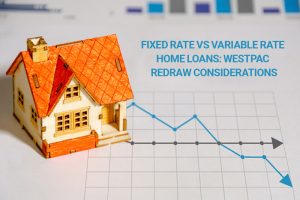
Are you considering a Westpac redraw home loan and wondering about the benefits of their redraw facility? You’re in the right place! We’ll dive deep into the world of Westpac’s redraw facility and offset accounts, helping you understand their features, benefits, and how to make the most of them.
By the end of this article, you’ll have all the information you need to make a well-informed decision based on your financial goals and needs.
Short Summary
- Westpac’s Redraw Facility offers access to additional repayments, competitive variable rates, and multiple offset accounts.
- It is important to consider the advantages and disadvantages of both Westpac’s redraw facility and offset account before making a decision that best suits individual financial goals.
- Consulting with a mortgage specialist can provide tailored advice for navigating Westpac’s redraw options.
Westpac Redraw Facility Explained

- Access to additional repayments made towards their home loan balance
- Competitive variable rate
- Multiple offset accounts
- Ability to make extra repayments
- Simple online application process
By understanding how an offset account works in conjunction with Westpac’s redraw facility, clients can access a source of finance, enjoy peace of mind, and find it more cost-effective than a credit card or personal loan.
However, it’s essential to ensure that you are able to make the necessary repayments should you choose to withdraw money using the redraw facility.
How to access the redraw facility
Accessing the redraw facility is easy and can be done in various ways. You can:
- Transfer money to other accounts you hold with your bank
- Make payments via BPay
- Transfer funds to accounts you hold with other providers
- Use an ATM or EFTPOS if you have a card attached to your home loan
- Set up direct debits on your home loan.
However, there may be restrictions on withdrawing funds from ATMs and certain fees and minimum amount restrictions depending on the lender.
To check the balance of your redraw facility, you can access it online through the online banking platform or contact Westpac’s home loan customer care team.
Fees and restrictions associated with Westpac redraw
Westpac does not impose any fees for redrawing or depositing funds via its redraw facility. However, they may impose limits on the amount and frequency of redraws in any given period, and it may not be possible to redraw money from an ATM or to transact using a debit card.
It’s always beneficial to have a dialogue with your lender regarding the matter to understand any applicable fees and restrictions.
Comparing Westpac redraw with other lenders
While both Westpac’s redraw facility and those offered by other lenders aim to reduce interest costs, an offset account may offer more flexibility in accessing funds. An offset account functions like a regular transaction account and provides access to your funds while reducing the interest rate of your home loan.
A redraw facility gives you the ability to access additional repayments that you have made on your home loan. This can help save money on interest. To determine the best option for your needs, it’s essential to weigh the pros and cons of each option based on your personal circumstances and financial goals.
Offset Account vs Redraw Facility: Westpac Edition

Both options can help reduce the amount of home loan interest charged over the course of an eligible home loan, potentially resulting in savings that can be used for achieving a home loan sooner, or for:
- early repayment
- investments
- holidays
- other large purchases
To make the best decision for your needs, consider the savings, fees, and loan product availability of each option.
Pros and cons of each option
An offset account, which can also be considered a type of savings account, offers flexibility in accessing funds and the potential to reduce the amount of interest charged on your home loan, depending on the account balance. However, offset accounts can incur higher fees than redraw facilities, which may offset some of the interest savings achieved.
Redraw facilities, on the other hand, provide access to additional repayments made on your home loan, resulting in lower interest costs. The main disadvantage of an account or redraw facility is the potential fees and limitations on the amount that can be redrawn.
When deciding between an offset account and a redraw facility, it is important to consider the fees and limitations of each option, as well as the amount of money you are looking to access. In the “redraw vs offset” debate, offset accounts may be more suitable for those who require regular access to their funds, while redraw facilities may be better suited for those who want to prioritize paying off their mortgage and limit the temptation to spend their additional funds.
Which one is better suited for your needs
The most suitable option between Westpac’s offset account and redraw facility depends on your personal financial goals and circumstances. If you need more flexibility in accessing your surplus funds and want to minimize the interest you pay on your home loan, an offset account might be the right choice for you. On the other hand, if you want to focus on paying off your mortgage and limit your temptation to spend additional funds, a redraw facility may be a more suitable option.
Ultimately, it’s essential to weigh the pros and cons of each option and consult a mortgage specialist to help you make the best decision for your needs.
Maximizing the Benefits of Westpac Redraw Facility

By implementing these strategies, you can optimize your savings, reduce fees, and better control your cash flow.
Making extra repayments
Making additional repayments towards your home loan can have multiple benefits. Extra repayments can help reduce the outstanding balance of your loan, which in turn reduces the amount of interest charged over the course of the loan. You can make additional payments on a fortnightly, monthly, or lump-sum basis when you have extra funds available.
By making extra repayments, you can potentially pay off your loan faster and save on interest costs.
Timing your redraws wisely
Optimizing the timing of your redraws is crucial to maximizing your savings. Consider taking redraws when interest rates are low, using redraws when extra cash flow is available, and utilizing redraws to take advantage of investment opportunities.
By strategically timing your redraws, you can optimize interest savings, reduce fees, control cash flow, and take advantage of investment prospects.
Combining redraw facility with other loan features
Combining Westpac’s redraw facility with other home loan features can offer increased flexibility and control over your finances. For example, borrowers can access extra repayments they have made on their home loan using the redraw facility, allowing them to use the funds for other purposes such as settling other debts or making investments.
Combining a redraw facility with other loan features can also help borrowers save on interest payments, as they can access the extra repayments they have made on their home loan and use them to make additional repayments on their loan.
Fixed Rate vs Variable Rate Home Loans: Westpac Redraw Considerations

Understanding the redraw options for each type of loan can help you determine the best choice for your needs.
Redraw options for fixed rate home loans
Westpac provides a redraw facility for fixed rate home loans, enabling customers to access any extra repayments they have made. The redraw facility is accessible online, and customers can access their available redraw balance whenever they wish.
However, it is important to note that when transitioning from a variable rate home loan to a fixed rate home loan, the redraw facility will no longer be available during the fixed rate period.
Redraw options for variable rate home loans
Westpac also offers a redraw facility for variable rate home loans, allowing customers to access any additional repayments they have made on their loan. The redraw facility is accessible online, and customers can view their available redraw balance at any time.
It’s important to compare the different features and restrictions offered by different lenders before making a decision, as fees and limitations may vary.
Refinancing with Westpac: Adding a Redraw Facility

However, it’s important to weigh the advantages and disadvantages of incorporating a redraw facility during refinancing, as well as the fees and restrictions associated with it.
Steps to refinance with Westpac
Refinancing with Westpac involves submitting an application for a new loan, transferring the existing loan to the new loan, configuring the redraw facility, and fulfilling the required repayments. Before applying for a home loan online, it’s essential to research lenders, compare rates and features, and submit the necessary supporting documents.
Once the loan is approved, you’ll need to sign the loan documents, remit any associated fees, and have the loan funds deposited into your account.
Assessing the benefits of adding a redraw facility during refinancing

It’s crucial to weigh the benefits and drawbacks of adding a redraw facility during refinancing to determine if it’s the right choice for you.
Managing Your Westpac Redraw Facility Online

With Westpac’s online banking, you can easily view your redraw balance and make a withdrawal.
Accessing and using the redraw facility online
To access and utilize Westpac’s redraw facility through online banking, simply follow these steps:
- Log in to your account.
- Submit a request to redraw funds from your home loan.
- View your available redraw balance and track your redraw transactions online.
This makes it easy to stay informed about your financial situation.
By managing your redraw facility online, you can ensure you’re making the most of this valuable feature and optimizing your savings.
Monitoring your available redraw balance
Keeping track of your available redraw balance with Westpac’s online banking tools is essential to managing your finances effectively. By signing into online banking or the Westpac app and selecting your home loan account, you’ll be able to view your balance and any available redraw funds.
Monitoring your available redraw balance can help you make informed decisions about when to make additional repayments or withdraw funds from your home loan balance minus any outstanding amount.
Tax Implications of Using Westpac Redraw Facility

In this section, we’ll explore the tax deductibility of redrawn amounts and compare the tax implications of using a redraw facility with those of an offset account.
Tax deductibility of redrawn amounts
Redrawn amounts that are not being used for investment purposes may not be eligible for tax deductions. In other words, if you redraw funds from your home loan and use them for personal expenses, such as buying a car or going on vacation, you won’t be able to claim a tax deduction on those amounts.
It’s essential to consider the tax implications of using a redraw facility and consult with a qualified tax professional to determine how it may affect your individual tax situation.
Comparing tax implications with offset accounts
When comparing the tax implications of Westpac’s redraw facility and offset accounts, it’s important to note that using an offset account will not influence the tax deductibility of interest charged on your loan. In contrast, with a redraw facility, you may not be able to claim tax deductions on the redrawn funds.
As always, it’s important to consult a qualified tax professional to help you fully understand the tax implications of your financial decisions.
Expert Advice: Navigating Westpac Redraw and Offset Options

In this section, we’ll discuss the importance of consulting with a mortgage specialist and the key factors to consider when choosing between Westpac’s redraw facility and offset account.
Consultation with a mortgage specialist
Consulting with a mortgage specialist can provide you with the necessary information to make an informed decision about Westpac’s redraw and offset account options. Mortgage specialists have the expertise to evaluate the fees and restrictions associated with each option, as well as the advantages and disadvantages of each.
By seeking professional advice, you can ensure you’re making the best decision based on your personal circumstances and financial goals.
Factors to consider before making a decision
Before making a decision between Westpac’s redraw facility and offset account, it’s crucial to consider your financial goals and objectives. This includes understanding what you want to achieve, what is important to you, and what you’re willing to sacrifice. Additionally, it’s important to gather research and information on the available options, assess the advantages and disadvantages of each option, and consider the potential risks and uncertainties associated with each option.
In addition to assessing your financial goals and gathering information, you should also consider the following:
- The resources available to you, such as financial resources, time, and expertise
- The stakeholders who will be impacted by your decision
- The ethical ramifications of each option
By carefully considering all these factors, you’ll be better equipped to make the best decision for your needs.
Summary
In conclusion, understanding the differences between Westpac’s redraw facility and offset account can help you make an informed decision about which option is best suited for your needs. By considering factors such as fees, restrictions, interest savings, and tax implications, you can determine the most advantageous choice for your financial goals and circumstances. Don’t hesitate to seek professional advice from a mortgage specialist, who can provide personalized guidance and help you navigate the complexities of home loan features.
Frequently Asked Questions

Does Westpac have a redraw fee?
This means customers can access their extra repayments whenever they need them, without having to worry about any additional fees. It’s a great way to save money and make sure you’re always on time.
How does a redraw account work Westpac?
These services provide customers with greater control over their loan repayments, allowing them to manage their finances more effectively and save money in the long run.
What is a redraw on home loan?
It’s easy to use – simply make regular payments higher than the minimum and you’re good to go.
Which is better redraw or offset?
Redraw facilities, on the other hand, only allow access to extra repayments already made on the loan. Which one is better for you depends on your financial situation and the type of loan you have.
What are the tax implications of using Westpac's redraw facility?
However, if the redraw facility is used for investment purposes, then the amounts may be eligible for tax deductions.













